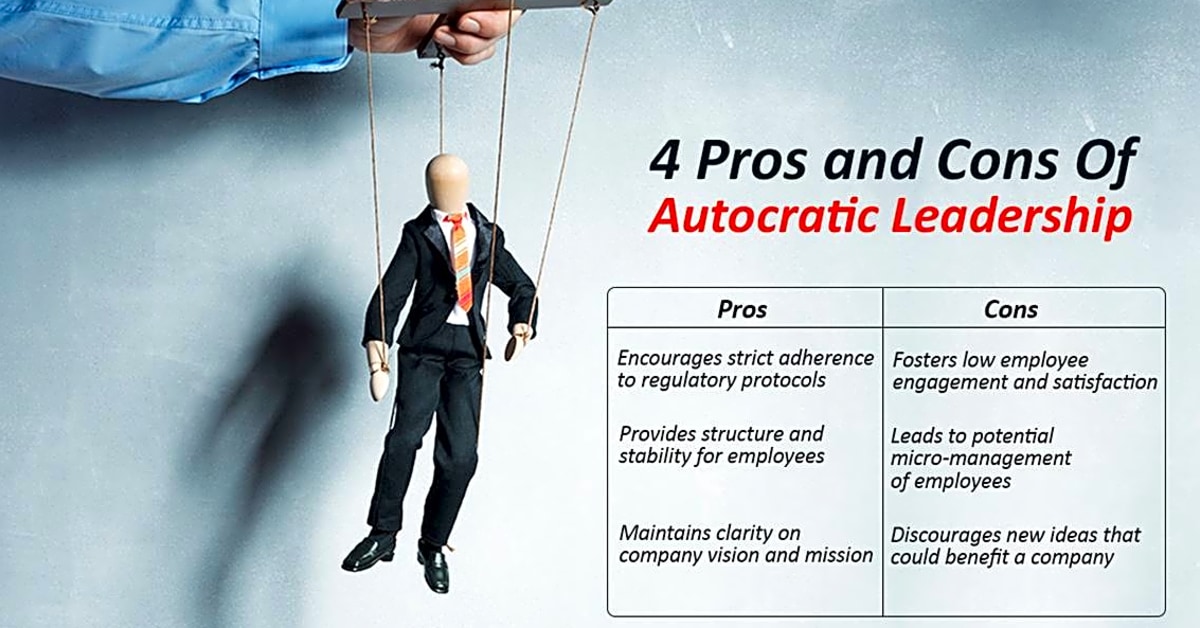Welcome to our article on the pros and cons of autocratic leadership. As one of the most debated leadership styles, autocratic leadership has its fair share of supporters and detractors. In this article, we will delve into the key characteristics of this style, its potential benefits and drawbacks, and why it is often considered a controversial approach to leadership.
Autocratic leadership is a style in which a leader holds complete control and makes decisions without seeking input from team members. This type of leadership is often associated with a strict hierarchy, with a clear division between leaders and followers. While some may view this as an effective way to maintain order and ensure efficiency, others argue that it can stifle creativity and lead to a lack of employee engagement.
In this article, we will explore the pros and cons of autocratic leadership in depth, providing you with a well-rounded understanding of this leadership style. Whether you are a leader looking to adopt a new approach or an employee navigating an autocratic environment, this article will provide valuable insights and considerations.
So, let’s dive into the world of autocratic leadership and discover its advantages, disadvantages, and everything in between.
In this article, we will explore the various aspects of autocratic leadership and how it can affect a team. Autocratic leadership is a style where the leader holds all the decision-making power and has total control over their team. This type of leadership can have both positive and negative effects on a team, making it important to understand the pros and cons before implementing it in your own leadership style.
One of the main advantages of autocratic leadership is that decisions can be made quickly and efficiently. With the leader having all the decision-making power, there is no need for lengthy discussions or debates, which can save time and increase productivity. This style of leadership also works well in situations where there is a clear hierarchy and tasks need to be completed in a timely manner.
However, with all the power resting in one person, there can also be disadvantages to this style of leadership. One major con is that it can lead to a lack of creativity and innovation within the team. When team members do not have a say in decision-making, they may feel discouraged from contributing their ideas and suggestions. This can result in a stagnant team that lacks diversity and fresh perspectives.
To improve your autocratic leadership skills, it is important to listen to your team members and consider their opinions. While you may have the final say, taking into account different perspectives can lead to more well-rounded decisions. Additionally, setting clear expectations and providing feedback can help build trust and create a more positive work environment.
Successful team building and problem solving are also crucial for effective autocratic leadership. As the leader, it is important to delegate tasks and responsibilities appropriately to ensure that each team member feels valued and has a sense of ownership over their work. Encouraging open communication and addressing conflicts as they arise can also help maintain a cohesive team dynamic.
In conclusion, while autocratic leadership can have its advantages, it is important to consider the potential downsides and ways to improve in this style of leadership. By listening to your team members and promoting a positive work environment, you can effectively utilize autocratic leadership in your own leadership style.
The Benefits of Autocratic Leadership
While autocratic leadership may not be the most popular style, it does have its advantages. One of the main benefits is that decisions can be made quickly and efficiently. With one person in charge, there is no need for lengthy discussions or debates, which can save time and increase productivity.
The Drawbacks of Autocratic Leadership
On the other hand, autocratic leadership can also have its drawbacks. With one person making all the decisions, there is limited room for input from team members. This can lead to feelings of resentment and disengagement from team members who may feel their opinions are not valued.
In conclusion, autocratic leadership can have both positive and negative effects on a team. It is important to weigh the pros and cons and consider the needs of your team before implementing this style. Remember, effective leadership involves finding a balance between being authoritative and being open to input from others.
